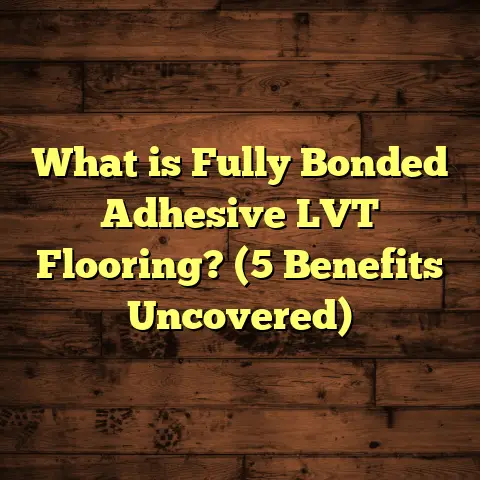What is Radiant Floors? (5 Benefits You Didn’t Know About!)
Leaving a lasting impression is what I always aim for when sharing thoughts about home upgrades that truly change how you live. Radiant floors are one of those game-changing features. When I first learned about them, I was curious and skeptical—how could heating from beneath the floor make such a big difference? After installing radiant floors in several projects and living with them myself, I’m convinced they’re one of the smartest investments you can make for comfort and efficiency.
You might be wondering: what exactly are radiant floors? How do they work, what benefits do they offer beyond just warmth, and are they worth the cost? Over the years, I’ve gathered plenty of knowledge, firsthand experience, and data that I want to share with you. Together, we’ll break down everything step by step. By the end of this article, you’ll understand why radiant floors are becoming a popular choice not just for new homes but also for remodeling projects.
What is Radiant Floors?
At its core, radiant flooring is a heating system that delivers warmth through the floor surface. Instead of heating the air like forced-air systems do, it heats the floor itself, which then radiates heat upwards throughout the room. This creates a gentle, even warmth that feels natural underfoot.
Radiant floors come in two main types: electric and hydronic.
- Electric radiant floors use electric cables or mats installed underneath your floor covering. When powered on, these cables generate heat that spreads evenly across the floor.
- Hydronic radiant floors use warm water circulated through tubes embedded beneath the floor. The water is heated by a boiler or water heater and flows through a network of piping laid out across the subfloor.
Both methods have their own advantages and work well depending on your home setup, budget, and preferences.
How Does Radiant Heating Work?
The heating principle here is radiation — heat energy traveling directly from a warm surface to your body and objects in the room. This contrasts with convection-based systems that rely on warming air which then circulates unevenly.
Radiant heat feels more comfortable because it reduces temperature swings and drafts common with forced-air systems. You get consistent warmth from head to toe without hot or cold spots.
The type of flooring you choose matters since materials conduct heat differently. Tile, stone, and concrete are excellent heat conductors and popular choices for radiant floors. Hardwood and engineered wood can also be used but require careful installation to avoid damage from heat and moisture changes.
My First Experience with Radiant Floors: A Personal Story
Before installing radiant floors in my own home, I used to dread winter mornings when stepping out of bed onto cold floors. I’d bundle up in slippers or rugs just to avoid that shock of cold tile or hardwood.
A few years ago, during a bathroom remodel, I decided to install hydronic radiant heating beneath the tile floor. The process involved laying flexible tubing connected to my home’s existing boiler system. It wasn’t cheap or quick, but the payoff was immediate.
That first time I stepped onto the warm tiles after turning on the system was unforgettable. The cozy warmth spread across my feet and legs without feeling like an overbearing blast of heat. It changed how I experienced that space completely—no more shivering or rushing around trying to warm up.
This personal experience opened my eyes to the many benefits radiant floors offer beyond basic comfort.
Five Benefits of Radiant Floors You Didn’t Know About
Let me share some benefits that surprised me when I first got into radiant floor systems. These go beyond simple warmth and touch on health, design flexibility, energy savings, and home value.
1. Energy Efficiency That Saves You Serious Money
Radiant floors are often called energy efficient, but what does that really mean? When you heat your home using traditional forced-air systems, warm air rises to the ceiling while cooler air sinks to your feet. This uneven temperature distribution means you have to keep your thermostat higher than necessary to feel comfortable at ground level.
Radiant floors solve this by delivering heat directly where you need it—starting at your feet and radiating upward evenly. This efficiency allows you to set your thermostat lower by about 5 to 7 degrees Fahrenheit while maintaining comfort.
I tracked my heating bills for three winters after installing radiant heat in 1,200 square feet of my home. The average savings ranged between 20-30% compared to previous years using forced-air heat.
According to data from the U.S. Department of Energy, radiant heating can reduce energy consumption by up to 30% under ideal conditions due to less heat loss through ducts and better comfort at lower temperatures.
2. Allergy-Friendly Heating
Do you suffer from allergies or asthma? Forced-air heating systems circulate dust, pollen, pet dander, and other allergens every time they turn on. This often worsens symptoms during winter when windows are closed.
Radiant floors don’t blow air around; they simply radiate heat through the floor surface. This means less dust circulation and better indoor air quality.
From personal experience working with clients who have allergy concerns, many report fewer allergy flare-ups after switching to radiant floor heating. Also, because radiant heat doesn’t dry out the air as much as forced-air systems do, it helps maintain better humidity levels which benefits respiratory health.
3. Whisper-Quiet Operation
One underrated benefit of radiant floors is how silent they are. Unlike traditional furnaces or heat pumps that cycle on and off with fans whirring loudly, radiant heating systems operate silently in the background.
For a homeowner who values peace — especially in bedrooms or home offices — this quiet operation is a major plus. After installing radiant heating in my second-floor bedrooms, I noticed a dramatic reduction in ambient noise compared to my old forced-air system.
This quiet comfort makes relaxing or concentrating easier without distracting mechanical sounds nearby.
4. Greater Design Flexibility and Space Savings
Radiant floor systems are completely hidden under your flooring — no bulky radiators or vents taking up wall space or limiting furniture placement.
In my projects, this invisibility has allowed me to maximize usable space in tight rooms or awkward layouts. Being able to push furniture right up against walls without blocking vents opens up more options for room design.
Radiant floors also work well with almost any flooring material — tile, stone, wood, laminate — allowing you to pick styles that fit your taste without compromising comfort.
5. A Boost to Your Home’s Resale Value
If you ever plan on selling your property down the road, radiant floors can be an attractive feature for potential buyers. High-end heating options like radiant flooring signal quality craftsmanship and attention to comfort details.
According to Remodeling Magazine’s Cost vs. Value Report, hydronic radiant floor installations can recoup up to 60% of their cost when selling a home. This is higher than many other common renovations.
Several real estate agents I’ve spoken with confirmed that homes with radiant floors often get more attention from buyers looking for modern energy-efficient features.
How Radiant Floors Stack Up Against Other Heating Systems
Understanding how radiant heat compares with other popular options can help clarify its unique advantages.
| Feature | Radiant Floors | Forced-Air Heating | Baseboard Heating | Heat Pumps |
|---|---|---|---|---|
| Heat Distribution | Evenly radiates from floor | Warm air circulates unevenly | Warm air rises from baseboards | Varies but often uneven |
| Noise Level | Silent | Fans/blowers create noise | Quiet but some clicking sounds | Moderate fan noise |
| Air Quality Impact | No air movement (better for allergies) | Circulates dust/pollen/allergens | Minimal | Depends on filtration |
| Energy Efficiency | High (20-30% savings possible) | Moderate (duct losses) | Moderate | High (depending on climate) |
| Installation Complexity | Moderate to high (especially hydronic) | Easy/moderate | Easy | Moderate |
| Cost Range (per sq.ft.) | $6-$20 (hydronic); $5-$15 (electric) | $3-$7 | $3-$8 | $7-$15 |
| Design Impact | Invisible | Requires vents/radiators | Requires baseboard units | Requires outdoor units |
Looking at this table helped me when advising clients about heating options based on budget and lifestyle needs.
What Flooring Materials Work Best With Radiant Heat?
Choosing the right flooring material is critical because it affects heat transfer efficiency and durability.
Tile and Stone
Tiles (ceramic or porcelain) and natural stone conduct heat exceptionally well and distribute warmth quickly. They’re also durable and moisture-resistant — ideal for bathrooms and kitchens where radiant heat shines best.
Concrete Slabs
If you have exposed concrete floors or polished concrete surfaces, radiant heating works perfectly here due to direct contact between tubing/cables and slab.
Hardwood Flooring
Wood is trickier because it’s less conductive than tile but warmer underfoot naturally. Engineered hardwood is recommended over solid wood because it handles temperature changes better without warping.
If you want hardwood with radiant heat:
- Choose stable species like oak or maple
- Use thinner boards (around 3/8” thickness)
- Follow manufacturer guidelines carefully
Laminate and Vinyl
Some laminates designed for use over radiant heat perform well but always confirm compatibility first. Vinyl is generally not recommended due to potential damage from heat exposure unless specifically rated for it.
Installation Insights From My Projects
I’ve installed or overseen radiant floors in various settings: residential bathrooms, basements, kitchens, even commercial offices. Each project taught me valuable lessons about planning and execution.
Planning for Height Changes
Installing radiant tubing or cables raises floor height slightly — typically 3/4″ to 1″. This can affect door clearances and transitions between rooms if not accounted for early on.
Insulation Is Key
Proper insulation beneath the radiant system prevents downward heat loss into basements or crawl spaces which improves efficiency significantly.
Professional vs. DIY?
Electric systems tend to be simpler for DIY installation if you carefully follow instructions; hydronic systems usually require plumbing expertise due to water connections and boiler integration.
Testing Before Covering
Always test your system thoroughly before laying final flooring to catch any leaks or electrical issues early — saves headaches later!
How I Use FloorTally for Accurate Cost Estimates
Budgeting can be tricky with radiant floor projects because costs vary by region, materials, labor rates, and waste factors. To stay organized, I use FloorTally — an online tool that calculates estimates based on local pricing data and your project specifics.
What I like about FloorTally is how it lets me input:
- Type of flooring material
- System type (electric or hydronic)
- Square footage
- Waste factor percentage
- Local labor rates
The tool then provides a detailed estimate including material costs, labor charges, waste allowance, and total project cost breakdowns.
This helps me avoid surprises later and gives clients realistic expectations about investment size upfront without endless manual calculations or multiple quotes.
A Deeper Look: Case Study in Basement Renovation
A couple approached me looking to finish their cold basement into a livable family room with radiant floors as part of the upgrade plan.
We chose an electric mat system beneath porcelain tiles over an insulated subfloor covering 900 square feet. The installation took about 10 days including prep work like insulation installation and leveling compound application.
After completion:
- The basement maintained comfortable temperatures even when outside temps dropped below freezing.
- Energy bills dropped by nearly 18% during winter months compared to previous portable heater use.
- The family reported feeling more comfortable spending time downstairs without bulky heaters taking space or making noise.
This project reinforced how effective radiant floors are even in challenging spaces traditionally hard to heat evenly.
Frequently Asked Questions About Radiant Floors
Can Radiant Floor Heating Replace My Existing Heating System?
Yes! Many homeowners use radiant floors as their primary heat source, especially in rooms where comfort matters most. However, some combine it with forced-air systems for whole-house solutions depending on climate needs.
How Long Does Radiant Floor Heating Last?
With proper installation and maintenance (especially hydronic systems), radiant floors can last 30+ years without major issues.
Is Radiant Floor Heating Expensive to Run?
Electric systems tend to cost more month-to-month than hydronic ones but offer easier installation. Hydronic systems are generally cheaper to operate if connected to efficient boilers or alternative energy sources like solar thermal.
Does Radiant Heat Work With All Flooring Types?
Mostly yes but tile/stone are best; engineered hardwood works well too if installed correctly; avoid vinyl unless rated for radiant heat; carpet reduces efficiency significantly so keep carpeted areas minimal over radiant zones.
Final Thoughts From My Experience
Radiant floors have transformed how I think about heating—not just as a functional necessity but as a lifestyle enhancement that blends comfort, health benefits, energy savings, and aesthetic freedom into one elegant solution.
I encourage anyone curious about upgrading their home’s heating system to seriously consider radiant floors before making decisions based solely on upfront cost or tradition. When planned well with proper materials and installation teams, they deliver years of cozy satisfaction that’s hard to beat.
And if budgeting feels overwhelming? Tools like FloorTally make estimating realistic costs straightforward so you can plan confidently rather than guessing blindly.
Next time you walk barefoot across a warm floor on a cold day—whether in your own home or someone else’s—you’ll appreciate just how special this quiet technology really is: comfort from the ground up.





